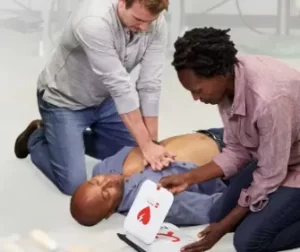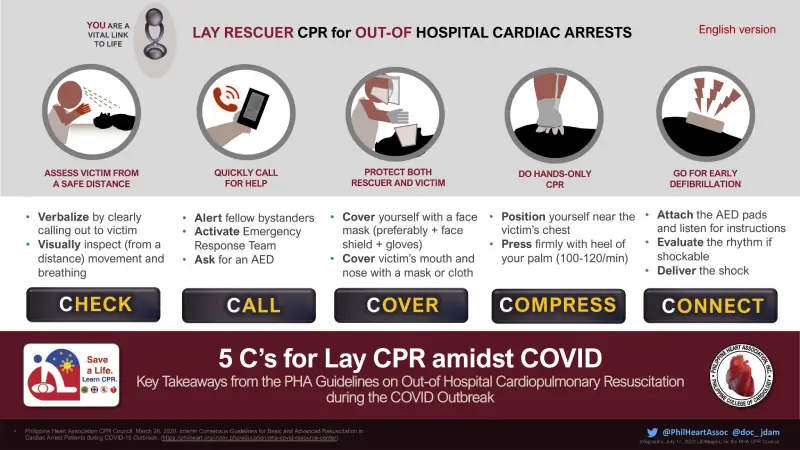How to perform CPR and use an AED in time of Covid?
What is a Safe Way for Lay Rescuers to perform CPR?
In this article we will focus on Out of Hospital CPR and AED procedures for Lay Rescuers who are untrained or are trained for Basic Life Support, based on the AHA, ERC and PHA guidelines.
All guidelines currently focus on a safe procedure and recommend focusing on Hand-Only CPR for Laymen rescuers

What is CPR?
Cardio-Pulmonary Resuscitation, generally called CPR, is an emergency procedure used to manually pump blood from the heart and to supply oxygen to the brain and other organs especially when an individual stops breathing or with abnormal breath i.e. cardiac arrest which may be caused by a blockage in coronary artery, profuse blood loss, shock, blockage of the airway among others.
What is the purpose of CPR?
To manually force the person’s heart to pump blood from the heart to all the vital organs inside the victim who suffers Sudden Cardiac Arrest and keep that person ‘artificially alive’ by pumping oxygenated blood through the body to all the vital organs (brains, heart, liver, kidneys etc.)
What steps do you follow if someone suffers Cardiac Arrest?
Check for Danger
Ensure the environment is safe for you before rendering help so you don’t put your own life in danger in the process.
Protect yourself from direct contact with body fluid, wear your gloves, face mask, and other protective equipment if available since the covid-19 physical distancing protocol is not achievable.
Check for Response
Impairment to the brain’s normal activities following a cardiac arrest episode affects unconsciousness. Responders are to observe if the person is aware of his environment; this can be achieved using the AVPU scale.
In all situations make sure to cover yourself with a N95 Mask.
The AVPU scale
A – Alert
Is the person aware of your presence?
V – Voice
Can he respond or hear your voice as you call and speak to him?
P – Pain
The back of the hand is a very sensitive part, slowly and gently pinch it to assess the casualty for pain and response to stimulus.
U – Unresponsive
If all the above fail, then the casualty is said to be in an unresponsive state and needs immediate help.
Check for Breathing
Check if the SCA victim is breathing by looking from a safe distance. Look at the person’s chest and stomach for signs of movement. Look for the rising and falling of the chest and stomach.
All above assessments should not take longer than 10 seconds.
Call for Help
Call for help while simultaneously checking for breath to maximize time, use your phone’s inbuilt speaker to communicate so you can multitask and follow instructions from emergency service.
And if you are with someone else, tell the person to make the phone call to the emergency hotline of the nearest hospital or local emergency number (always have these numbers preprogrammed in your cellphone). If a third person is available, appoint him/her to get the AED while you proceed with CPR.
How to perform Safe CPR as a Lay Rescuer?
Ensure you are well protected; wear a proper face mask for yourself and use another face mask to cover the mouth and nose of the victim to prevent exposure to aerosols that may be generated during chest compressions.
As an untrained responder (Lay Rescuer) without wasting much time, commence CPR without rescue breaths, once you have established that the individual has no breath, or even with abnormal breath (abnormal breath such as occasional gasp is considered as no breath).
This is also called ‘compression-only’ CPR and is commonly used in these Covid times to give the lay rescuer a safer rescue procedure. This procedure can be done by everyone, trained and untrained responders can still provide aid for individuals who experience sudden cardiac arrest before the interventions of the professionals.
Several studies have shown that adults with sudden cardiac arrest usually have oxygen in their system after the arrest. And for this reason, all that is most important is for their heart to pump out blood that would carry the oxygen to the brain and other organs which is achievable through effective chest compression.
In addition, due to the transmission mechanism of covid-19 and other infectious diseases, compression-only CPR has become more popular, and an effective and safer way to give CPR to anyone with little or no risk of contracting the disease.
HOW TO PERFORM HANDS-ONLY CPR
- Survey the environment to see that it is safe for you.
- Call your local emergency line or someone who could help,
- Wear your face mask, and wear another for the victim if available. If none is, find something to cover the mouth and nose of the casualty to reduce the escape of aerosols that may carry infection as you compress (use a cloth or cover face with the shirt of the victim).
- Then, put the heel of your dominant hand over the breastbone at the center of the chest
- Put the second hand over the dominant one, then interlock the fingers and ensure elbows are locked.
- Compress the chest hard and fast to the beat of the Bee Gees’ disco song “Stayin’ Alive.” The music is about 103 beats per minute which is almost equal to the minimum rate you should compress (compression rate is between 100-120 compression per minute).
The compression depth is about 4-5 cm (2 inches) which is about 1/3 of the chest cavity.
How to perform CPR with rescue breaths as a trained responder?
According to the AHA 2010 and ERC CPR Guidelines, it includes chest compressions and 2 artificial ventilations in the ratio of 30:2 (i.e 30 chest compressions to 2 artificial ventilation)
Ventilation can be delivered through the mouth to mouth, mouth to mask, and bag valve mask ventilation method. But as important as ventilation is, it is not considered as necessary as chest compression and can be discarded if you are not comfortable giving it or when it is not safe.
The covid-19 pandemic has also made it unsafe to deliver mouth-to-mouth ventilation because of the risk of getting infected; this has made HANDS ONLY CPR for first aiders and responders who would like to help strangers without known medical conditions become more popular.
Nonetheless, artificial ventilation can be performed on people in your household since you cohabit. It is hard and impossible for this category to follow the covid-19 protocol already.
The Bag-Valve-Mask (BVM) Ventilation Method
 For this procedure you need 3 trained rescuers; one that does CPR, one rescuer that folds the CPR mask and one that operates the Bag-Valve-Mask (BVM). The BVM employs the use of a respiratory kit made up of a self-inflating bag, a one-way valve, and a mask to seal the mouth and nose of the casualty.
For this procedure you need 3 trained rescuers; one that does CPR, one rescuer that folds the CPR mask and one that operates the Bag-Valve-Mask (BVM). The BVM employs the use of a respiratory kit made up of a self-inflating bag, a one-way valve, and a mask to seal the mouth and nose of the casualty.
With this technique, one can deliver high-quality oxygen that is better and safer than the one produced from the mouth.
As good as it is, it requires adequate and consistent practice to deliver sufficient amount of oxygen that’s required. In addition, it is usually applied when there is more than a responder available; one can help with the mask on the face while the other presses the bag for oxygen to be delivered.
How to use the AED?
To increase the chances of survival, use the Automated External Defibrillator if available.
Due to some reasons, the electrical activity of the heart may get disorganised thereby resulting in cardiac arrest. Delivering quality electric shock to the already fibrillated heart is necessary and effective in restoring the hearts normal electrical activity and rhythm through the use of an AED
Step-by-step on how to use the AED
- Get the AED.
- Open the case, then switch it on.
- Open the AED Electrode pads.
- Remove the backing.
- Apply the two electrode pads*
- Apply the first pad above the breast on the upper right.
- Apply the second below the armpit on the lower left chest.
- Be sure that the electrodes are attached correctly and in good contact.
- Stop CPR and let the AED analyse the heart rhythm. Ensure no one is touching him at this point.
- When the AED prompts that you deliver Shock
- Ensure nobody is touching the person, then,
- Press and hold the “shock” button until the AED delivers the shock.
- Continue CPR for another 1.5 to 2 minutes, then repeat the AED sequence.
- Repeat procedures over again.
*Apply the two Electrode Pads
The Philippine Heart Association 5 C’s guidelines
In the Philippines, The Philippine Heart Association has clear guidelines on how to perform safe Lay Rescuer CPR in times of COVID for Out-of-Hospital Cardiac Arrests.
These guidelines are called 5 C’s for Lay CPR amidst COVID:
1. Check – on the victim from a safe distance
2. Call – quickly call for help
3. Cover – protect both rescuer with a proper face mask and victim with a face mask or cloth.
4. Compress – do hands-only CPR
5. Connect – go for early defibrillation with an AED



Leave a reply